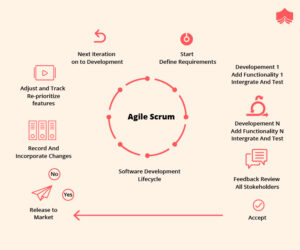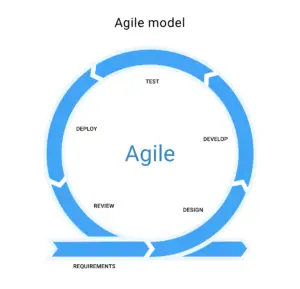Agile Methodology refers to?
Agility simply refers to more accuracy, transparency and quality in terms of productivity in Software development industry and it uses an alternate way to traditional SDLC process which is known as Agile Methodology.
Agile methodology allows a developer to improve, accept challenges and understand the requirements, from the base, through a continual module working process. Where developers followed a complete process from planning to testing, and able to resolve errors, bugs or coding issues into a module, easily.
What is the Agile SDLC model?
Agile is the most popular and widely used software development framework. The main aim of the Agile SDLC model is to facilitate faster project completion. It is a combination of iterative & incremental process models.
In the agile model, the software develops in multiple iterations or sprints, and at a time, one iteration is planned, developed, tested, and deployed to the customers. The developers concentrate on the high priority requirements in the first iteration and then deploy to the customers.
Based on the customer’s feedback, the requirements are enhanced/modified in further iterations. This process repeats until the achievement of the final desired quality product. Generally, one sprint or iteration lasts for about 2-8 weeks.
Steps involved in the agile SDLC model are:
- Requirement Gathering
- Requirement Analysis
- Design
- Coding
- Unit Testing
- Deployment
Scope of Life Cycle in Agile Framework

The range of life cycles of Agile in the SDLC framework may vary. It is so because the development of the solution in the flexible frame is a bit complicated. If the technical team adopts a developmental process, it does not fully address the complete cycle of an operation. Hence, it is recommended to go beyond the construction lifecycle.
On the other hand, with the Agile Framework, one can fine-tune the IT processes. Organizations usually have a lot of ideas in the stage of planning and production which they can execute with Agile Framework in SDLC.
Agile SDLC Process Flow

Phase 1: Requirements
Before a Product Owner can even start designing a project, they need to create the initial documentation that will list the initial requirements. They are:
- The end result of the project is going to achieve. For example, a text editor;
- The features that it will support. For example, different font sizes;
- The features that it will not initially support. For example, adding animations to the text or ability to embed video;
A general recommendation is to lower these initial requirements as hard as one can, adding only the definitely necessary features and ignoring ones that won’t be used often. Developers can work on them later, once the app is deployed and the core features work well.
NOTE: If developers choose to ignore this stage, they are prone to feature creep — a situation when new non-crucial features are constantly being added to the project, taking developers’ time away from the important tasks.
On further iterations, the Client and the Product Owner review the requirements and make them more relevant.
Phase 2: Design
There are two ways to approach design in software development — one is the visual design and the other is the architectural structure of the app.
Software Design
During the first iteration, the Product Owner assembles its development team and introduces the requirements created during the previous stage. The team then discusses how to tackle these requirements, and proposes the tools needed to achieve the best result.
For example, the team defines the programming language, frameworks, and libraries that the project is going to be using. On further iterations, the developers discuss the feature implementation and the internal structure of the come.
UI/UX Design
During this SDLC stage, the designers create a rough mock-up of the UI. If the product is consumer-grade, the user interface and user experience are most important. So it’s generally a good idea to review the possible competitors to see what they are doing right — and especially what they are doing wrong.
Further iterations are spent refining the initial design and/or reworking it to suit the new features.
Phase 3. Development and Coding
The development phase is about writing code and converting design documentation into the actual software within the software development process. This stage of SDLC is generally the longest as it’s the backbone of the whole process.
There aren’t many changes between the iterations here.
Phase 4. Integration and Testing
This stage is spent on making sure that the software is bug-free and compatible with everything else that the developers have written before. The Quality Assurance team conducts a series of tests in order to ensure the code is clean and the business goals of the solution are met.
During the further iterations of this SDLC stage, the testing becomes more involved and accounts not only for functionality testing, but also for systems integration, interoperability, and user acceptance testing, etc.
Phase 5. Implementation and Deployment
The application is deployed on the servers and provided to the customers — either for the demo or the actual use. Further iterations update the already installed software, introducing new features and resolving bugs.
Phase 6. Review
Once all previous development phases are complete, the Product Owner gathers the Development Team once again and reviews the progress made towards completing the requirements.
The team introduces their ideas toward resolving the problems that arose during the previous phases and the Product Owner takes their propositions into consideration. Afterward, the Agile software development lifecycle phases start anew — either with a new iteration or by moving toward the next stage.
Advantages of Agile SDLC
- Project is divided into short and transparent iterations.
- It has a flexible change process.
- It minimizes the risk of software development.
- Quick release of the first product version.
- The correctness of functional requirements is implemented in the development process.
- Customer can see the result and understand whether he/she is satisfied with it or not.
Disadvantages of Agile SDLC
- The development team should be highly professional and client-oriented.
- New requirements may be a conflict with the existing architecture.
- With further correction and change, there may be chances that the project will cross the expected time.
- There may be difficult to estimate the final cost of the project due to constant iteration.
- A defined requirement is absent.